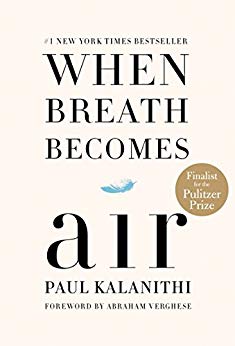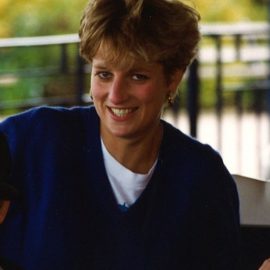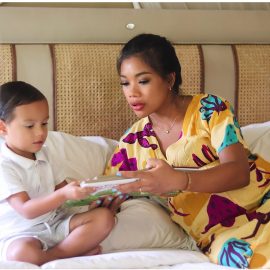

This article is an excerpt from the Shortform summary of "When Breath Becomes Air" by Dr. Paul Kalanithi. Shortform has the world's best summaries of books you should be reading.
Like this article? Sign up for a free trial here .
Cady Kalanithi is Paul Kalanithi’s daughter with Lucy Kalanithi. She is featured in her father Paul’s memoir When Breath Becomes Air.
Though Paul’s diagnosis was a shock to him and his family, they wanted to continue to help Paul live a full and enriching life. Paul and Lucy made the decision to have a baby. Of course, this was not an easy decision. Read more to find out how Paul and Lucy made this decision, and what Cady Kalanithi’s birth meant to Paul as he dealt with cancer.
Shortform note: This article and our summary of When Breath Becomes Air is written in a way that allows you to share in the experience provided by the memoir.
Simply reading about the content of the story seems insufficient in expressing the emotional journey. To really provide you with the sensation this book creates, we wrote in the first person, using a voice similar to his. We highly recommend reading the original book for the full experience. Reading the words coming directly from him is a powerful experience we can’t replace.
Deciding to Have a Child
Shortform note: Paul Kalanithi’s daughter, Cady Kalanithi, was born a little more than a year after his diagnosis. In this section, Paul explains the decision to have a family while he was facing a terminal illness.
Emma challenged me to concentrate on my values and priorities, rather than my chances. These thoughts included those of being a father, and Lucy and I revisited our thoughts on having a child. We both felt that if human relationality was the foundation of a meaningful life, a child could only enhance that. She was concerned about whether raising a child was the right choice for me for whatever time I had left. I was concerned about whether raising a child alone and simultaneously caring for a sick husband was the right choice for her life.
We reasoned that there was no way to know what the future held for me or us, but living in wait for death was not living at all. With our families’ approval, we decided to live despite death. We decided to live without a clear picture of the future, which was what everyone did. We were going to start a family.
There was irony in the process of creating life. With in vitro fertilization, multiple embryos would be created and implanted. Only those viable would survive. The rest would die. There was no escaping death, even when the goal was to introduce life.
Cady Kalanithi’s Birth
Shortform note: Paul continued to battle cancer and try to map out his new life during Lucy’s pregnancy. Paul Kalanithi’s daughter, Cady Kalanithi, was born after Paul went through initial treatment and was seeking new options.
Forty pounds lighter since my diagnosis, I was slated for discharge from the hospital. I was back to my eighth-grade weight. I was lucid again but worn. My skin was a mere sheath over my bones, and simple acts, like keeping my head upright or drinking a glass of water, were taxing. And I was no longer able to read.
Treatment would have to wait until I was in better shape, and experimental trials were out of the question in my condition. The next time I saw Emma, she told me that I likely had another five years ahead of me, but the words rang hollow. She was no longer the poised, assertive guide. She was a hopeful companion in the dark tunnel searching for light.
On my way home from meeting with Emma, Lucy went into labor. My father brought me to the hospital, and on a cot, I lay in the delivery room covered in blankets and heating packs. We waited for two hours for Lucy’s final push. On the Fourth of July, our daughter, Elizabeth Acadia, was born. We called her Cady for short.
I held my swaddled baby and Lucy’s hand at the same time, both of us peering down into the face of life. The finality of my death was still a question, but instead of all the “what ifs,” holding Cady, I now saw a clean slate on which anything was possible.
Pauls Final Hours with Cady at his Side
Shortform note: The final pages of When Breath Becomes Air are written by Paul’s wife, Lucy. She describes how Paul died on March 9, 2015, in the hospital with his loved ones by his side. Cady Kalanithi was eight months old, and was with her father in his final days.
Paul’s treatment stopped working a few months earlier, at Christmas. He became weaker but kept living as best as he could. They had friends over for dinner, played with Cady, and continued to enjoy each other’s love and companionship. Paul also worked on this book. During his last months, finishing the book was of the utmost importance to him.
The transition to spring brought a resurgence of life in the natural world while Paul’s life continued to wane. In February, he was put on oxygen to help his breathing. More scans were done, showing the growing grip of the cancer in his lungs and the spreading of it to his brain. The new brain tumors brought a shortened life expectancy and would eventually lead to neurological deficits.
The ensuing deterioration of his mind was particularly crushing for Paul, fearing the loss of meaning and independence. Thwarting these devastating effects became the main goal of whatever treatment he would receive.
Lucy remained strong for Paul, but on the inside, her heart was breaking. She didn’t know how much time they had left together, but she never thought it would only be a matter of days.
For his final weekend, Paul’s family came to their house and spent time with him and Cady. Paul knew he wasn’t likely to finish his manuscript either due to time or his physical capacity. But he still put it aside that day, preferring to be present with his family.
The family was hoping Sunday would bring more of the same. More time to relax and enjoy each other’s company, maybe go to church. But Paul spiked a fever and slept for most of the day. By Sunday night, Paul’s health took a dramatic turn. He couldn’t breathe and was taken to the ER. He knew, as they all did, he was unlikely to leave the hospital again.
The doctors suggested intubating him, and Paul and Lucy discussed and struggled over the decision. Intubation would keep him alive, but at what cost? Could his current ailments improve to a point where he could come off ventilation? Or would he continue to deteriorate, his brain and organs shutting down?
The other option was comfort care, an action that was certain to lead to rapid death. Paul’s main question regarded his quality of life even if he was able to recover from the respiratory issues. With the cancer in his brain, was there a good reason to lengthen his time if he would not be lucid enough for it to have meaning? He signed a “Do Not Resuscitate” and decided to sleep on it.
In the morning, his attention turned again to comfort care and the possibility of dying at home. But Lucy knew his condition was delicate and that he might not make it home. It was decided that she would bring home to him. The only thing he wanted was Cady.
Paul lay with Cady in his arms while the doctors commiserated over what was left to do. But Paul knew what he wanted. He turned to Lucy and said, “I’m ready.”
Shortform note: Paul shares a touching relationship with his daughter, Cady Kalanithi, throughout his memoir. His revelations and reflections on life and death are moving and heartfelt. Paul Kalanithi’s daughter, Cady Kalanithi clearly was incredibly impactful to him, and is one of the most profound parts of When Breath Becomes Air.

———End of Preview———
Like what you just read? Read the rest of the world's best summary of Dr. Paul Kalanithi's "When Breath Becomes Air" at Shortform .
Here's what you'll find in our full When Breath Becomes Air summary :
- How Paul Kalanithi discovered he had cancer
- How Paul coped with his cancer until his very end
- How Paul's wife dealt with his death and found the strength to continue






